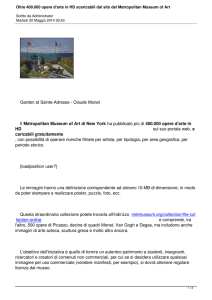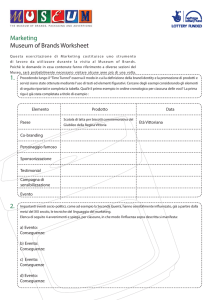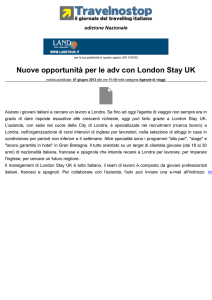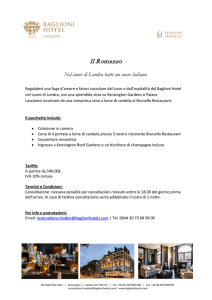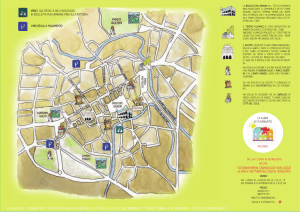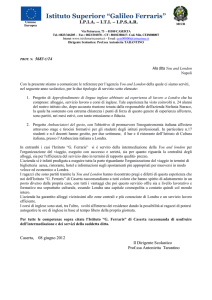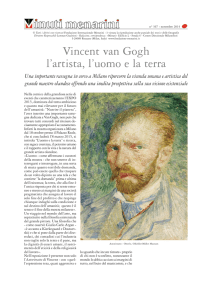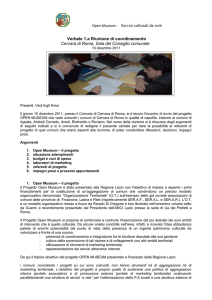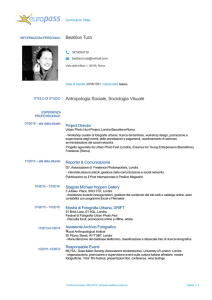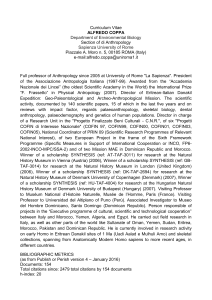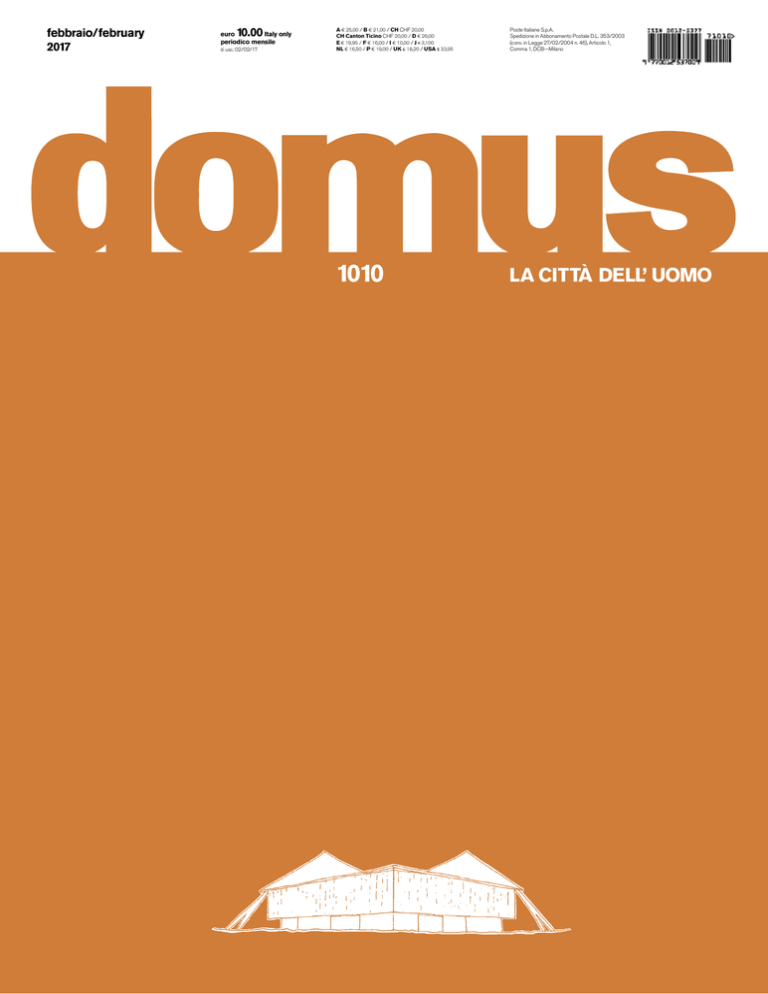
febbraio/february
2017
10.00
euro
Italy only
periodico mensile
d. usc. 02/02/17
A € 25,00 / B € 21,00 / CH CHF 20,00
CH Canton Ticino CHF 20,00 / D € 26,00
E € 19,95 / F € 16,00 / I € 10,00 / J ¥ 3,100
NL € 16,50 / P € 19,00 / UK £ 18,20 / USA $ 33,95
Poste Italiane S.p.A.
Spedizione in Abbonamento Postale D.L. 353/2003
(conv. in Legge 27/02/2004 n. 46), Articolo 1,
Comma 1, DCB—Milano
1010
LA CITTÀ DELL’ UOMO
domus 1010 Febbraio / February 2017
Autore / Author
SOMMARIO/CONTENTS IX
Progettista / Designer
Nicola Di Battista
Titolo
X Editoriale
Della consapevolezza
Coriandoli
Collaboratori /
Consultants
Cristina Moro
Salvatore Peluso
Traduttori /
Translators
Paolo Cecchetto
Daniel Clarke
Barbara Fisher
Emily Ligniti
Annabel Little
Dario Moretti
Richard Sadleir
Edward Street
Rodney Stringer
Wendy Wheatley
Fotografi /
Photographs
Aldo Ballo
Andrea Basile
Hélène Binet
Matteo Bergamini
Richard Bryant
Matteo D’Eletto
French and Tye
Carlo Gardini
Gareth Gardner
David Grandorge
Andrea Jemolo
Mitsuo Matsuoka
Gilbert McCarragher
Ugo Mulas
Carlo Pedroli
Matteo Piazza
Paúl Rivera
Title
Editorial
On awareness
Confetti
Michael Jakob
1 Collage, 2017
Collage, 2017
Johann Joachim
Winckelmann
2 Della bellezza;
e ch’egli è impossibile di definirla
On beauty;
and the impossibility of defining it
Stephen Taylor
8 Costruire a grandi lettere
Building writ large
Luisa Collina
12 Scuola del Design, Politecnico di Milano
School of Design, Politecnico di Milano
Gevork Hartoonian
18 Una genealogia dell’architettura moderna
A genealogy of modern architecture
Pier Luigi Sacco
22 Cultura e sviluppo locale
Culture and local development
Bruno Corà
27 Nella luce di Burri
In the light of Burri
Marco Romanelli
28 Ritrovare Ico Parisi
Rediscovering Ico Parisi
Antonio Calabrò
32 La fabbrica bella
The beautiful factory
Manuel Orazi
Stefano Cordeschi
Salvatore Settis
36 Il cronotopo del 1966
The 1966 chronotope
40 Progetto urbano negli ex Mercati generali,
Roma
Urban renewal in the former Mercati
Generali, Rome
44 Costituzione, tutela, terremoti
Constitution, protection and earthquakes
Progetti
John Pawson
John Pawson, OMA,
Allies and Morrison
The Design Museum London
64 Pragmatismo, sviluppo e cultura:
il modello Londra
Pragmatism, development and culture:
the London model
Tadao Ando Architect
and Associates
68 Ampliamento della dépendence di Oyodo,
Osaka
Extension of the Oyodo annex, Osaka
Vittorio Magnago
Lampugnani
74 Parcheggio multipiano, East Hanover,
New Jersey, USA
Parking garage, East Hanover,
New Jersey, USA
Pierre d’Avoine Architects
80 Residenza estiva, San Salvatore,
Montione, Umbria
Summer residence, San Salvatore,
Montione, Umbria
Carlo Contin
88 “Se leggo dimentico, se guardo ricordo,
se faccio capisco”
“If I read I forget, if I look I remember,
if I do I understand”
Giuseppe Penone
94 Matrice ed Equivalenze
Origins and Equivalences
Ricky Burdett
Tadao Ando
Projects
47 The Design Museum London
Si ringraziano /
With thanks to
Enrica Caffarra (Archivio storico
comune Parma)
Nicoletta Ossanna Cavadini
(m.a.x. museo Chiasso)
Virginia McLeod (Phaidon)
Francesco Moschini e/and
Gabriel Vaduva (AAM)
Feedback
Dario Costi
104 La Parma di Dario Costi
Michael Jakob
111 Gimme Shelter
Elzeviro
Rassegna
Centro Studi Domus
In copertina: elaborazione
grafica di uno schizzo di progetto
(a destra) di John Pawson per
il Design Museum di Londra
© John Pawson
• Cover: graphic interpretation
of the sketch (right)
by John Pawson for
The Design Museum London
© John Pawson
Feedback
Dario Costi’s Parma
Elzeviro
Gimme Shelter
Rassegna
114 Abitare contemporaneo
Contemporary living
128 Autori
Contributors
domus 1010 Febbraio / February 2017
64 PROGETTI/PROJECTS
Ricky Burdett
nato a Londra nel 1956,
è vissuto a Roma e ha
completato i suoi studi in
Gran Bretagna. Ha fondato
la 9H Gallery e l’Architecture
Foundation di Londra.
È stato direttore della Biennale
di Architettura di Venezia nel
2006. È professore di Urban
Studies alla London School of
Economics and dirige il centro
ricerche LSE Cities and the
Urban Age.
La storia del Design Museum rispecchia quella di Londra. In
quella che è stata la prima megalopoli del pianeta, gli ultimi
decenni sono stati testimoni di enormi cambiamenti: dalla
città grigia e provinciale degli anni Ottanta a icona ipercosmopolita, Londra si è riposizionata sia in senso spaziale sia
in senso simbolico. La capitale britannica è ora più grande, più
giovane e più varia di quanto sia mai stata. A dispetto della
Brexit, la città sta per raggiungere i 10 milioni di abitanti,
con la maggior parte dei residenti nata fuori dal Regno
Unito, mentre il suo centro di gravità continua a spostarsi,
principalmente verso est. Il Design Museum, conversione del
Ventunesimo secolo di una struttura della metà del Ventesimo
situata nell’ottocentesco Holland Park, rappresenta solo
l’ultimo esempio della sorprendente capacità che Londra ha
di reagire e adattarsi. L’influsso delle élite internazionali,
la crescita esponenziale (e il crollo… e la nuova crescita)
del valore degli immobili, la battaglia tra conservazione e
progresso, i conflitti tra interessi pubblici e privati, la sete di
profitto e cultura, le tensioni metropolitane tra est e ovest
sono tutti elementi che compongono le articolate narrative
che soggiacciono alla nascita del più recente polo culturale
londinese. Ambientata sullo sfondo di un nuovo complesso di
edifici residenziali nel cuore del Royal Borough of Kensington
and Chelsea – il quartiere cittadino in cui risiede una buona
parte della classe conservatrice di proprietari terrieri della
capitale –, la vicenda che ha portato alla trasformazione del
Commonwealth Institute nel Design Museum è un prodotto
del singolare dinamismo che caratterizza Londra al passaggio
tra il Ventesimo e il Ventunesimo secolo.
Cinquant’anni fa, all’epoca della costruzione del
Commonwealth Institute, Londra era introspettiva, provinciale
e austera. Nel 1961, quando toccò terra nel raffinato contesto
di Holland Park, la parabola in cemento dell’istituzione
coloniale deve essere apparsa simile all’astronave Enterprise.
Concepita come un’enorme tenda usata per esporre prodotti
provenienti dalle ex colonie britanniche, era perfettamente
adatta alla sua funzione e ha goduto del favore di uomini
politici e scolaresche. Tuttavia, alla fine del Ventesimo secolo,
il Commonwealth Institute si ritrovava privo di ragion
d’essere, di energie e di fondi. Il suo caratteristico tetto in rame
ondeggiava nei giorni di forte vento, la pioggia penetrava nel
salone centrale e gli spazi espositivi circolari sotto l’enorme
soffitto erano ormai vuoti. Eppure, la peculiare costruzione
progettata dallo studio RMJM otteneva un decreto di
conservazione da parte del Governo quale uno dei soli due
edifici di valore storico costruiti a Londra nel Dopoguerra.
Come in molti altri esempi londinesi, lo status legale della
costruzione e il valore del terreno avrebbero determinato il suo
futuro, più che il suo intrinseco merito architettonico.
In questo periodo gli operatori immobiliari hanno iniziato
a volteggiare intorno al sito, tra i più appetibili in uno dei
quartieri residenziali più ricercati di Londra, affacciato
sull’aristocratico Holland Park. Una zona in cui le case si
vendono per un minimo di 15 milioni di euro, a crescere
fino a cifre stratosferiche. Nel 2007, poco prima del collasso
finanziario, il sito del Commonwealth Institute è stato venduto
a un consorzio privato. Nel 2016, il nuovo insediamento
Ricky
Burdett
THE DESIGN MUSEUM
Pragmatismo, sviluppo
e cultura:
il modello Londra
realizzato sulla base del master plan di OMA, con al centro il
Design Museum, è stato presentato sotto il marchio “Holland
Green”: con un semplice scarto linguistico, il nome ne indica la
posizione e si appropria della sua storia.
Ma risaliamo nel tempo di 50 anni, fino all’epoca in cui il
Commonwealth Institute fu costruito. Erano i giorni in cui
Terence Conran, giovane designer e imprenditore, introduceva
oggetti e mobili eleganti e vivaci nel frusto panorama degli
interni domestici inglesi. I suoi negozi Habitat e i suoi
ristoranti di tendenza avevano un grande successo, offrendo
“buon gusto immediato […] per chi è al passo con i tempi”.
All’inizio della sua fortunata carriera, Conran traeva
ispirazione da ciò che vedeva, tra gli altri luoghi, alla Triennale
di Milano. E quando nei primi anni Ottanta si ritrovò con “un
bel po’ di soldi”, creò la Conran Foundation, la cui missione era
ispirare ed educare il pubblico ai valori del design di qualità. A
trarne beneficio fu innanzitutto il Design Museum, che debuttò
con mostre alla Boilerhouse del Victoria & Albert Museum
per poi spostarsi, dal 1989, nella sua prima sede nell’ex area
portuale di Shad Thames, situata sulle rive del Tamigi di
fronte al Tower Bridge.
Nulla di tutto questo è avvenuto per caso. All’epoca, Londra
cominciava a risvegliarsi del depresso torpore degli anni
Ottanta, marcati dalle politiche di Margaret Thatcher.
L’apertura della City alle banche internazionali e i primi segni
della globalizzazione spingevano la capitale a trovare spazio
per stare al passo con la concorrenza. I Dockland, nell’est della
città, con i loro terreni abbandonati e i magazzini deserti,
divennero il perno di un lungo processo d’investimenti che
continua fino a oggi. Conran è stato tra i primi a investire
nell’area. Ma, a 20 anni dall’inaugurazione, le strutture del
Design Museum facevano fatica a contenere la sua crescente
attività. Al timone c’era il critico, saggista e curatore di design
Deyan Sudjic, già direttore di Domus, pronto all’azione insieme
a Conran. Questa volta, però, puntando a ovest.
Qui le diverse narrative s’intersecano. Nell’ottimismo dei
giorni che precedevano il 2007, denaro, terreni, architettura,
cultura, politica e pianificazione urbanistica hanno fatto
collisione per realizzare il ‘nuovo’ Design Museum. I
proprietari del sito che ospitava il Commonwealth Institute
volevano costruire appartamenti per la fascia più alta del
mercato. La posizione era perfetta. Il Royal Borough of
Kensington and Chelsea, il cui lavoro era concedere i permessi
di costruzione, voleva restaurare l’edificio e tenerlo aperto al
pubblico come struttura culturale. Gli abitanti del quartiere
erano contrari a ogni forma di sviluppo urbanistico. E, come
sappiamo, il Design Museum stava cercando una nuova sede.
Serviva una soluzione in grado di soddisfare questi propositi
apparentemente inconciliabili. Gli operatori immobiliari,
capeggiati dai veterani del settore Stuart Lipton e Elliott
Bernerd, si sono prontamente mossi per organizzare un
concorso internazionale. Su consiglio dell’autore, a diversi
importanti studi di architettura è stato chiesto di proporre idee
per un nuovo insediamento residenziale capace di collegarsi in
scala e volume al delicato contesto urbanistico e di rispettare il
Commonwealth Institute quale potenziale istituzione culturale
pubblica. Al concorso hanno preso parte Rafael Moneo, Viñoly,
Caruso St John Architects and Eric Parry Architects, ma la
soluzione più convincente è stata proposta da OMA. Ispirati
dai Lakeshore Drive Apartments di Mies van der Rohe, gli
architetti hanno immaginato tre torri residenziali di medie
dimensioni disposte intorno alla rinnovata struttura a
parabola. Un dato fondamentale era la visibilità dalla vicina
strada principale, così come lo era l’ambizione d’introdurre un
linguaggio architettonico sicuro e contemporaneo, capace di
reggere il confronto con le energiche forme dell’Institute e con
il solido paesaggio urbano che caratterizza il circondario.
Fedeli alla parola data, le autorità locali hanno insistito che
non si sarebbe costruita sul terreno alcuna unità abitativa a
domus 1010 Febbraio / February 2017
meno che non si trovasse un’attivita culurale e pubblica per
il Commonwealth Institute. È stato così diramato un appello
pubblico, ma solo un numero limitato di istituzioni culturali
sono state selezionate come possibili candidati. Un mediatore
vicino alle parti ha interpellato Terence Conran. Insieme a
Sudjic, Conran ha notato il potenziale dell’edificio e della sua
posizione. Si è giunti così a un accordo: il Design Museum si
sarebbe trasferito negli spazi del Commonwealth Institute
purché si fosse addivenuti a un’intesa economica vantaggiosa
per entrambe le parti.
Anziché costruire sul sito abitazioni a costo sostenibile,
gli operatori immobiliari avrebbero coperto i costi per la
ristrutturazione dell’edificio (circa 20 milioni di sterline) e
offerto al Design Museum un contratto d’affitto gratuito per
375 anni. In questo modo, il settore privato copriva il valore
del terreno, offrendo inoltre un contributo sostanziale per la
realizzazione del progetto. La Conran Foundation ha donato il
controvalore della sede di Shad Thames e il Design Museum
ha raccolto il resto dei fondi necessari per coprire il budget
di circa 100 milioni di euro. Il piano d’intesa si è dimostrato
complesso e ha richiesto lunghe trattative, ma alla fine è
stato raggiunto un accordo e i permessi di costruzione sono
stati concessi nel settembre 2009, proprio quando il mercato
immobiliare crollava in tutto il mondo occidentale.
Contro ogni aspettativa il progetto è andato avanti, i soldi sono
stati trovati, gli appartamenti costruiti e venduti, e il Design
Museum ha aperto i battenti nel novembre 2016. Mentre si
discute sulla relativa equità della transazione – alla luce delle
fluttuazioni di valore durante la gestazione del progetto – il
processo che ha dato vita al Design Museum si è rivelato tanto
innovativo quanto istruttivo. Senza le autorità incaricate di
concedere i permessi, il programma non sarebbe mai partito.
Senza il Design Museum, gli investitori non avrebbero
ottenuto le concessioni edilizie per le unità residenziali.
Senza gli investitori, il Design Museum non si sarebbe potuto
permettere la sua nuova sede.
In un’epoca in cui c’è carenza di denaro pubblico e in cui il
prezzo del terreno edificabile in città come Londra continua
ad aumentare, la collaborazione creativa tra una fondazione
privata (Conran), un immobiliarista e proprietario terriero
(Chelsfield and Ilchester Estates), l’amministrazione locale
(Kensington and Chelsea) e un’istituzione culturale (il Design
Museum) rappresenta una storia di successo.
Il risultato di questa iniziativa avrebbe potuto essere un
pot-pourri architettonico. Invece, mentre il progetto è ancora
in fase di collaudo da parte dei nuovi residenti e dei visitatori
del museo, l’intervento nel suo insieme produce un inatteso
e gradito senso di coesione. La relativa distanza tra l’edificio
degli anni Sessanta e Kensington High Street è stata mediata
dalla geometria dei nuovi condomini, costruiti intorno all’ex
Commonwealth Institute, che presenta un orientamento
ruotato di 45 gradi rispetto alla griglia urbana prevalente
nella zona. L’innalzamento del piano inferiore del blocco
residenziale più a sud apre prospettive visuali sul percorso
verso l’ingresso principale del museo, rendendolo facile da
identificare. L’organizzazione del paesaggio a cura dello
studio West 8 funziona bene nello sfumare i confini tra uno
dei complessi residenziali più esclusivi di Londra e il normale
spazio pubblico che collega il museo alla città e al vicino
Holland Park. Ma ancora più importante, forse, è che il puro
e semplice numero di persone in transito verso il più recente
polo culturale della capitale crea il senso di una ragion d’essere
e di un’identità che trascendono le limitazioni del sito e della
sua geometria.
Una volta ricevuto l’incarico, OMA ha lavorato a stretto
contatto con Arup e Allies and Morrison per rendere più
aperto un edificio strutturalmente complicato e ripristinarne
il rivestimento esterno. Si è trattato di un’operazione
tecnicamente complessa, costosa e rischiosa, che ha richiesto
PROGETTI/PROJECTS 65
il sollevamento dell’intera struttura per inserire un piano
interrato a doppia altezza e spazi espositivi con soffitti alti,
nonché la rimozione dei solai esistenti. Le pareti esterne sono
state sostituite con nuove facciate in vetro sinterizzato che per
colore e texture ricordano quelle originali e che permettono
alla luce naturale di penetrare nella struttura sui due lati
affacciati a sud ed est, mentre le viste in direzione delle unità
residenziali sono oscurate per impedire l’intrusione visiva in
spazi privati.
Per usare un’analogia presa a prestito dal settore immobiliare,
i proprietari del terreno (con OMA) hanno fornito l’involucro,
mentre il Design Museum si è assunto in toto la responsabilità
per l’organizzazione degli spazi interni e il loro arredo. Con
la sua lunga esperienza di designer di allestimenti espositivi
e in quanto architetto dalle straordinarie capacità tecniche,
John Pawson è stato selezionato per ridisegnare gli interni.
Il suo design misurato combina l’espressionismo dinamico
degli anni Sessanta con un minimalismo riconfigurato nel
Ventunesimo secolo. L’intervento di Pawson è molto più di
una ristrutturazione. Si tratta di una completa revisione
della struttura preesistente con una macchina museale
moderna, che comprende archivi e studi per designer assieme
a ristoranti, caffè, sale studio e spaziose sale espositive,
tutti elementi fondamentali nell’esigente piano di attività
del Design Museum. Come risultato, le sottigliezze del
vecchio edificio sono talvolta oscurate e talvolta amplificate,
il che solleva questioni sulle difficoltà che un designer
contemporaneo affronta nel reinterpretare edifici concepiti in
tempi non lontani con funzioni, dotazioni economiche e regimi
di gestione del tutto diversi.
Entrare in questo singolare ‘tendone’ degli anni Sessanta
è come scoprire un motore McLaren da Formula 1 sotto il
cofano di una sgargiante Chevrolet degli anni Cinquanta. Il
volume organico coperto dalla parabola originale è sostituito
da un atrio centrale ortogonale che si apre in tutta l’altezza
dell’edificio. Balconate orizzontali con pavimenti in rovere
marcano i diversi livelli. La luce naturale filtra attraverso
due pareti laterali e dal tetto. Come nella Turbine Hall della
Tate Modern, lo spazio centrale ha la funzione di orientare e
si realizzerà pienamente non appena il museo avrà occupato
i suoi diversi spazi e l’esperienza del visitatore si farà più
densa e forte. Tuttavia, esso agisce già da ambiente pubblico di
riferimento, che può facilmente sdoppiarsi come palcoscenico
per performance, sala conferenze o teatro di eventi mirati alla
raccolta di fondi.
Nella sua elegante sede di West London, il nuovo Design
Museum ha già richiamato 200.000 visitatori nel corso dei
primi mesi dall’apertura, più di quanti ne accogliesse in
un anno nella sede di East London. La missione di Terence
Conran, dare una collocazione solida al design nell’ambito
di uno spazio pubblico con accesso gratuito, viene rafforzata
da questo nuovo capitolo scritto da Deyan Sudjic e dai suoi
collaboratori. Ma, in quanto artefatto urbano complesso, il
successo del Design Museum trascende la sua architettura, le
sue collezioni e il gradimento del pubblico.
Il processo è in realtà interessante almeno quanto il
prodotto. In quanto tale, riflette un responso pragmatico a
una sofisticata serie di programmi, operazioni finanziarie,
aspirazioni culturali e politiche. La giustapposizione di
partner inattesi, le élite che occupano i complessi residenziali
e un museo pubblico, non è poi molto diversa dalla stessa
Londra: organica, lievemente disorientante ed estremamente
pragmatica. Il grande storico dell’architettura John
Summerson ha descritto l’urbanistica inglese ottocentesca
come una “felice coincidenza d’intenti e circostanze”. Due
secoli dopo, gli stessi attributi possono essere applicati alla più
recente operazione urbana di Londra, una pregevole aggiunta
alla vita culturale della città e al suo patrimonio architettonico
del Ventunesimo secolo.
domus 1010 Febbraio / February 2017
66 PROGETTI/PROJECTS
Ricky Burdett
was born in London in 1956
and lived in Rome until
completing his studies at
university in the UK. He was
the founder of the 9H Gallery
and Architecture Foundation in
London and director the Venice
Architecture Biennale in 2006.
He is Professor of Urban
Studies at the London School
of Economics and directs LSE
Cities and the Urban Age
programme.
The story of the Design Museum mirrors the story of
London. The last decades have seen tumultuous change in
the world’s first megacity. From a declining, provincial, grey
city of the 1980s to uber-cosmopolitan icon, London has
repositioned itself – spatially and symbolically. The city is
now bigger, younger and more diverse than it’s ever been.
Despite Brexit, it is soon to reach ten million people, with
most of the new residents born outside the UK. Its centre
of gravity keeps on moving, mainly eastwards. The Design
Museum, a 21st conversion of a mid-20th century structure
in a 19th-century park, is only the latest act of London’s
surprising capacity to react and adapt.
The influx of international elites, the exponential rise
(and fall… and rise) in property values, the battle between
preservation and progress, the conflicts between public and
private interests, the unquenchable thirst for culture and
profit, and the metropolitan tensions between east and west
define the complex narratives that lie behind the birth of
London’s newest cultural venue. Positioned in the midst of a
cluster of new apartment buildings in the heart of the Royal
Borough of Kensington and Chelsea – the city’s grandly
named district that accommodates much of London’s
conservative land-owning class – the transformation of
Commonwealth Institute into Design Museum is a product
of London’s unique dynamics at the turn of the 20th and
21st centuries.
Fifty years ago, when the Commonwealth Institute
was realised, London was inward-looking, parochial
and austere. The Candela-like concrete parabola of the
colonial institution must have appeared like the Spaceship
Enterprise when it landed in genteel Holland Park in
1961. Its abstract geometry “appeared free of negative
connotations of imperialism”, conceived as a massive tent to
exhibit products of former British colonies. It was fit-forpurpose and enjoyed by schoolchildren and politicians.
By the late 20th century, the Institute had run out of
purpose, steam and money. Its distinctive copper roof
flapped in high winds, rain penetrated the grand hall and
the curved exhibition spaces under the great canopy were
empty. Yet, the singular building designed by modernist firm
RMJM was given a protection order by the Government
as one of only two distinguished post-war buildings in
London. The heritage industry was adamant that it was
worthy of preservation and respect, even though no obvious
use was on offer (especially a civic entity that could fund
its activities). As with many other things in London, the
building’s legal status and land value was to determine its
future more than its intrinsic architectural merit.
Shrewd property companies began circling around this
most appetising of sites in one of London’s most desirable
residential districts overlooking the aristocratic Holland
Park. Houses in this area sell for a minimum of £15
million, rising to stratospheric prices that appeal to global
elites. By 2007, just before the global financial crash,
the Commonwealth Institute site was sold to a private
consortium. By 2016, the new OMA-masterplanned
development, with the new Design Museum at its core,
Ricky
Burdett
THE DESIGN MUSEUM
Pragmatism, Development
and Culture:
the London Model
was rebranded “Holland Green”. As a linguistic twist it
signals its location and appropriates its history but also
denotes London’s willingness to embrace the market and
absorb change.
Going back half a century to the time the Commonwealth
Institute was built, the young designer and entrepreneur
Terence Conran introduced bright, stylish objects and
furniture – Japanese paper lanterns and tubular-steel
chairs – into fusty English households. His Habitat shops
and trendy restaurants did well, offering “instant good
taste … for switched-on people”. In his early days, Conran
drew inspiration from what he saw, amongst others, at
the Milan Triennale. When he found himself with “rather
a lot of money” in the early 1980s, he created the Conran
Foundation. Its mission was to inspire and educate the
public with the values of good design. Its main beneficiary
was the Design Museum, starting with exhibitions at The
Boilerhouse at the Victoria & Albert Museum and then in
its first home from 1989 in the suitably grungy docklands
area of Shad Thames, overlooking Tower Bridge on the bank
of the River Thames.
None of this was by chance. London was just then
beginning to re-awaken from the depressed slumbers
of the Thatcherite 1980s. The opening up of the City to
international banks and the early signs of globalisation
forced London to find space to keep up with the competition.
Docklands in East London, with empty land and redundant
warehouses, became the focus of a long process of
investment which lasts to this day. Conran was one of the
first to invest here. But 20 years after opening its doors, the
Design Museum had outgrown its premises. Design critic,
author and curator Deyan Sudjic – a former editor
of Domus – was at the helm and together with Conran
on the move – but this time they went west.
Here the different narratives intersect. Money, land,
architecture, culture, politics and planning all collided
in the realisation of the “new” Design Museum in the
optimistic days before 2007. The new landlords of the
Commonwealth Institute site wanted to build exclusive
apartments for the top-end of the residential market. The
location was perfect. The Royal Borough of Kensington and
Chelsea – whose job it was to grant planning permission
– wanted to restore the collapsing building and keep it
open to the public as a cultural facility. The influential
neighbours were against any form of development – and, as
we know, the Design Museum was looking for a new home.
A solution had to be found to satisfy these seemingly
irreconcilable agendas. The developers, led by London’s
veteran property dealers Stuart Lipton and Elliott Bernerd,
moved swiftly to organise an international competition.
With the advice of the author, several architectural
practices of distinction were asked to come up with ideas
for new housing that related in scale and volume to the
sensitive urban context and respected the Commonwealth
Institute as a potential civic facility. Rafael Moneo, Viñoly,
Caruso St John Architects and Eric Parry Architects
all took part but OMA proposed the most convincing
solution. Inspired by Mies van der Rohe’s Lakeshore
Drive apartments, the designers envisaged three mediumsized residential towers arranged around the refurbished
parabola structure. Visibility from the nearby high street
was critical as was the ambition to introduce a confident,
contemporary architectural language which could stand up
to the forceful shapes of the Institute and the solid domestic
urban landscape of the neighbourhood.
True to its word, the planning authority insisted that not
one housing unit could be built on the site unless a public
user could be found for the Commonwealth Institute.
An open call was made to stimulate interest but only a
domus 1010 Febbraio / February 2017
handful of cultural institutions were shortlisted as serious
candidates. Through a close mediator, Terence Conran was
approached. Conran and Sudjic saw the potential of the
building and its location. A deal was eventually struck.
The Design Museum would move into the Commonwealth
Institute as long as a mutually beneficial financial
agreement could be reached.
In lieu of providing affordable housing on the site (the
normal requirement for residential schemes in London),
the developers would cover the costs of the enabling works
to the structure of the building (around £20m) and offer
the Design Museum a 375 year rent-free lease in one of
London’s most prestigious addresses. The private sector
contributed the land value as well as a considerable
financial contribution towards the realisation of the project.
The Conran Foundation generously donated the cash value
of the Shad Thames building and the Design Museum
raised the balance of funds to make up the budget of
roughly £100m. The deal was complex and took a long time
to negotiate but in the end an agreement was reached and
planning permission received in September 2009, just as
the residential market collapsed in London and much of the
western world.
Against all odds, the project proceeded, funding was raised,
the residential apartments built and sold, and the Design
Museum opened in November 2016. While there is some
debate as to the relative equity of the transaction – given
the fluctuating values during the lifetime of the project –
the process that has given rise to the new Design Museum
is both innovative and instructive. Without the planning
authority, the agenda would never have been set. Without
the Design Museum, the developers would not have got
planning approval for the commercial housing. Without the
developers, the Design Museum could not have afforded
their new home.
In an age of diminished public funding (of housing, the
arts and services) and increasing land values in a city
like London, the creative collaboration between a private
foundation (Conran), a developer and landowner (Chelsfield
and Ilchester Estates), the local authority (Kensington and
Chelsea) and a cultural entity (the Design Museum) is a
success story. Its complex interrelating narratives match
the broader coalitions, compromises and deals being struck
across London as a whole, as the city realises its assets and
moves forward to meet the challenges of an ever-changing
urban society.
What could have resulted from this process is an
architectural smörgåsbord. While the complete project is
still being test-driven by the new residents and visitors to
the museum, there is an unexpected and welcome sense
of clean, sparkling newly-wed cohesion to the whole. The
relative distance of the 1960s building from Kensington
High Street has been mediated by the geometry of the
apartment blocks which find their place around the
Institute orientated at an awkward 45 degrees to the
prevailing urban grid. The lifting of the lower floors of
the southernmost residential tower opens up views of
the route to the main entrance, making it easy to find (a
major challenge of the old building while it was in use).
The landscaping by West 8 does well to blur the boundaries
between one of London’s most exclusive developments and
the genuine open public realm that connects the museum
to the city and the neighbouring Holland Park. Most
importantly, perhaps, the sheer number of people – a new
demographic for West London – making their way to the
city’s newest cultural facility provides a sense of purpose
and identity that transcends the limitations of the site
and its geometry.
Once appointed, OMA worked closely with Arup and Allies
PROGETTI/PROJECTS 67
& Morrison to open up the structurally complex building
and re-clad its exterior. This was a technically difficult,
expensive and risky operation which required jacking
up the entire structure to insert the Design Museum
requirements for a double-height basement, high-ceilinged
galleries and remove existing irregular floorplates. The
external walls were carefully replaced with new fritted
glass facades that in colour and texture are reminiscent of
the original but importantly bring in natural light along the
two elevations facing south and east, while views towards
the residential apartments remain obscured to limit
overlooking and visual intrusion.
To use an analogy borrowed from the commercial property
sector, the landlords (with OMA) provided the shell-andcore while the Design Museum took on full responsibility for
the interior organisation and fit-out of the building. As an
experienced exhibition designer and supremely technicallyskilled architect who understands the dynamics of the
Design Museum, John Pawson was selected to work within
the restructured Commonwealth Institute shell. His suave
design negotiates the dynamic expressionism of the 1960s
with a reconfigured minimalism of the early 21st century.
Pawson’s intervention is much more than a “refurbishment”.
It is a wholescale re-imagining of a pre-existing structure
with a totally modern museum machine that incudes
archives and designer studios alongside restaurants,
café, learning rooms and spacious new galleries – all
fundamental to the demanding business plan of the Design
Museum (it does not charge admission fees). As a result, the
subtleties of the older building are at times obscured and at
times magnified, raising questions about the difficulties of
a contemporary designer repurposing buildings conceived
not so long ago for very different uses, funding and
management regimes.
Entering the quaint 1960s’ tent is like finding a McLaren
racing engine under the bonnet of a flamboyant 1950s’
Chevrolet. The organic volume covered by the original
parabola is replaced by an orthogonal central atrium that
rises the full height of the building. Horizontal oak-lined
balconies mark the different levels emphatically. Daylight
penetrates from two lateral walls and the roof. Like the
Tate Modern’s Turbine Hall, the central space performs
an orientating function that will come into its own once
the museum occupies its multiple spaces and the visitor
experience becomes more dense and intense. Yet, it already
acts as defining public space that can easily double up
as a performance venue, lecture hall or location for fundraising events. In its stylish West London home, the new
Design Museum has already attracted over 200,000 visitors
through its doors in its first months, more than the “old”
museum did in a year in East London. Terence Conran’s
mission to place design firmly in the public realm for free
is being consolidated by this new chapter spearheaded by
Sudjic and his colleagues but the success of the Design
Museum transcends its architecture, its collection and its
public acceptance as a complex urban artefact.
The process is indeed as interesting as the product. As
such, it reflects a pragmatic response to a demanding
series of programmes, financial operations and cultural and
political aspirations. The spatial juxtaposition of unexpected
bedfellows – residential elites and a public museum –
is not unlike London itself: organic, slightly confusing
and highly practical. The great architectural historian
John Summerson described the early 19th English townplanning movement as ‘‘a happy coincidence of intent and
circumstance”. Two centuries on, the same attributes can
be applied to London’s latest urban operation, a welcome
addition to the city’s cultural life and its 21st-century
architectural heritage.

